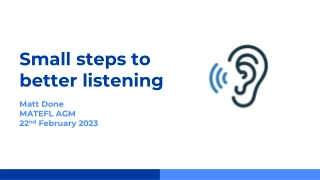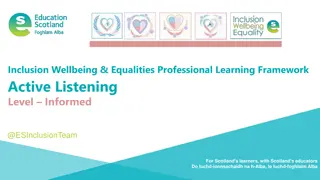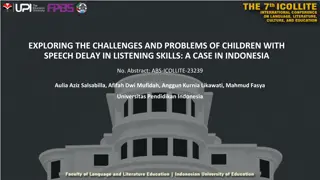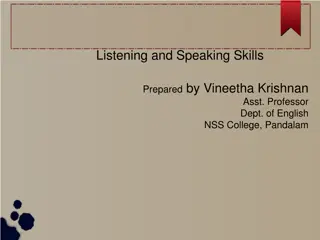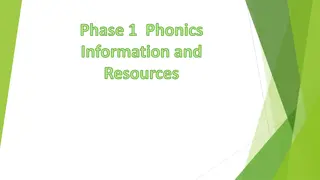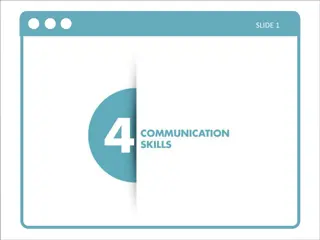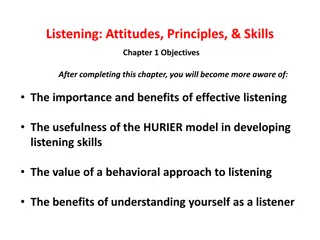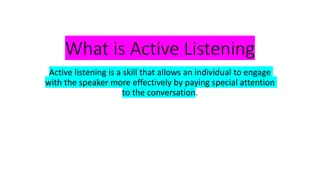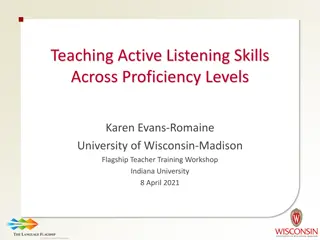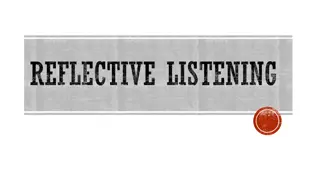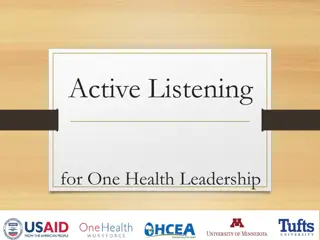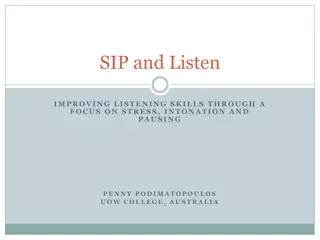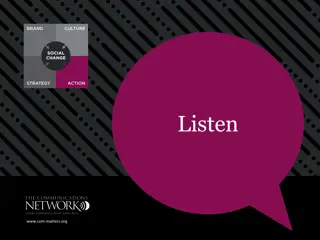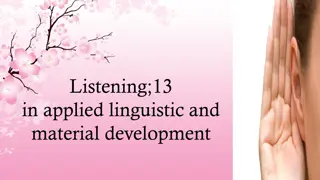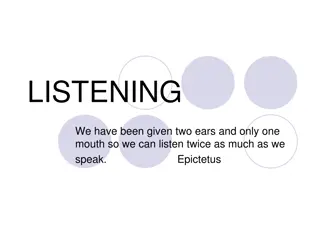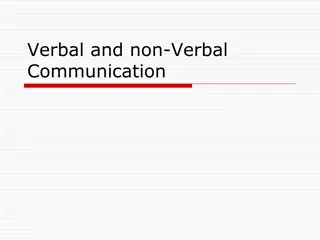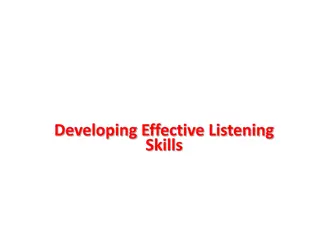Enhancing Listening Skills in Education
Listening is a critical skill that involves receiving, interpreting, and responding to messages. It comprises components like hearing, attending, interpreting, evaluating, remembering, and responding. Different from hearing, listening is purposeful, interactive, psychological, and involves active participation. Good listening is essential in educational settings for effective communication and comprehension. Techniques to improve listening skills include identifying barriers, understanding types of listening, and utilizing modern communication devices.
Download Presentation

Please find below an Image/Link to download the presentation.
The content on the website is provided AS IS for your information and personal use only. It may not be sold, licensed, or shared on other websites without obtaining consent from the author.If you encounter any issues during the download, it is possible that the publisher has removed the file from their server.
You are allowed to download the files provided on this website for personal or commercial use, subject to the condition that they are used lawfully. All files are the property of their respective owners.
The content on the website is provided AS IS for your information and personal use only. It may not be sold, licensed, or shared on other websites without obtaining consent from the author.
E N D
Presentation Transcript
Listening Skill Pratibha Khandelwal Assistant Professor Education Department Durga Mahavidyalaya
See full size image What is Listening? Achieving ability to comprehend material delivered at relatively fast speed; comprehending spoken material in standard Indian English, British and American English. Intelligent listening in situations. Advantages of listening. Hearing and listening. Essentials of good listening. Use of modern communication devices. Telephonic conversation.
Main topics Meaning and components of listening. Difference between hearing and listening. Significance of good (attentive) listening. Types of listening Barriers to listening Essentials of good listening Techniques to improve listening http://t1.gstatic.com/images?q=tbn:ANd9GcS6JgjRvvRmTkcXikGxKKKe-_FxM3sMRcmu3gNETWG0EvIBouOIO5jJuo0
Facts about listening Listening: Learned first, Used most (45%), Taught least. Speaking: Learned second, Used next most (30%), Taught next least. Reading: Learned third, Used next least (16%), Taught next most Writing: Learned fourth, Used Least (9%), Taught most. http://t2.gstatic.com/images?q=tbn:ANd9GcTD9_I_uSrwAnrLb359cHMtalKX77QlGngtgffTsEMJrojelTJhyhCGhVk
Meaning and components Listening is a process of receiving, interpreting and responding to the messages received from the sender. Listening is composed of 6 distinct components 1. Hearing 2. Attending(identification, focusing) 3. Interpretation (decoding) 4. Evaluation (deciding value) 5. Remembering (sending it to STM or LTM) 6. Responding
Difference between hearing and listening. Hearing Listening It is with senses & brain. It is automatic. It is not systematic. It is not purposeful. It is a one way process. It is physiological. It is a simple process. Person is passive. It is with mind. It is voluntary. It is systematic. It is purposeful. It is interactive. It is psychological. It is a complex process. Listener is active.
Significance of good (attentive) listening When a person listens to a spoken message by using his concentration power, experience, guesswork, prediction ability, logical sense etc. it is called intelligent listening. A good listener learns more than indifferent listener. An attentive listener stimulates better speaking by the speaker. A good listener can restructure vague speaking into clearer meaning. A good listener learns to detect assumptions, prejudices and attitudes. A good listener can understand and evaluate inferences and reasoning. A good listener can distinguish facts from opinion.
Types of listening Non listening (content is not needed) Pseudo listening Active or focused listening(from hearing to respond) Passive listening(responding is absent) Emphatic listening Selective listening Bottom line listening Evaluative listening Offensive listening Defensive listening Attentive listening
Barriers to listening(1) 1. Physical barriers Noise Physical discomfort Distance between speaker and listener Physical distraction 2. Psychological barriers Ego, anxiety, fear, stress, worry Lack of attention Poor motivation Negative attitude Bias and prejudices Closed mindedness
Barriers to listening(2) 3. Linguistic barriers Improper delivery Improper message decoding Ambiguous language Jargon 4. Cultural barriers Cultural differences Different values Different norms 5. Other barriers Difficult topic Time period and Difference in status
Essentials of good listening Be alert while listening. Exercise your mind(we listen faster than we speak so fill the gap in understanding). Resist distraction. Find areas of interest. Judge content, not delivery. Hold your fire. Be a flexible listener. Listen with open mind. Listen between lines(to tone , voice, stress...). Listen for ideas and not facts.
Techniques to improve listening http://t1.gstatic.com/images?q=tbn:ANd9GcTJo9OMARiVBnKoRlJvNsPEwjdHQ16bOSKWFV_liwRFx453vpfvQJ5w6zc
Techniques to improve listening Have desire to listen.(prepare physically, mentally....) Pay attention and be alert. Make no assumptions. Remove distractions. Be empathetic and patient. Monitor non-verbal. Take notes. Ask questions. Delay evaluation and premature conclusion. Try and understand speaker s perspective. Keep body language effective.
Questions asked in examination 1. What are the different techniques to improve listening ability. Differentiate between hearing and listening? 2. Describe the essentials of good listening. 3. What are the techniques to improve listening ability? Discuss. 4. Listening is a conscious activity the demands a lot more than just physical hearing. Discuss. 5. Write a short note on the importance of listening. Differentiate between listening and hearing. 6. How to become a better listener . Explain.


